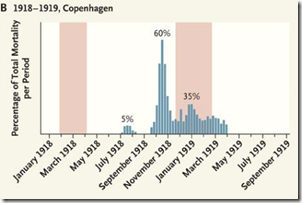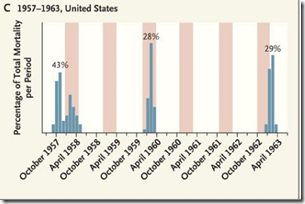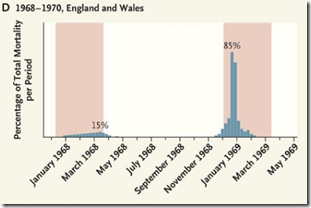# 3818
Anyone expecting the pandemic of 2009 to be over in 2009 (or probably even 2010) is setting themselves up for a big disappointment.
At least that’s the message today from the WHO (World Health Organization).
The novel H1N1 virus is almost certainly here to stay for a while as it travels around the globe, and if previous pandemics are any indication, won’t settle into becoming a `seasonal flu’ for a year or two.
Maybe longer.
First, this report from Reuters on the WHO pandemic statement today, then a look at some previous pandemics.
Could take years to lower pandemic alert level – WHO
Fri Oct 9, 2009 11:06am EDT
* Pandemic flu could become seasonal-like virus in 2-3 years
* Spread slows with rising immunity from exposure, vaccines * "No indication" of slowdown so far, nor any big mutations
By Laura MacInnis
GENEVA, Oct 9 (Reuters) - It could take years for the World Health Organisation to downgrade the H1N1 flu from a pandemic to seasonal-like virus, the U.N. agency said on Friday.
The WHO moved its six-point pandemic alert level to the top rung in June in response to the spread of the new virus widely known as swine flu, which has killed at least 4,500 people, especially in North America.
WHO spokesman Gregory Hartl said that health warning would stay in place until people can better fend off infection from the H1N1 strain.
"At some point in the future, there would be a recognition of the fact that if it's no longer circulating on a sustainable basis in communities. Then you would lower the pandemic level," he said, while stressing: "There is absolutely no indication yet of that happening."
The next three graphs come from NEJM (The Signature Features of Influenza Pandemics ) and demonstrate just how variable pandemics can be.
The 1918 pandemic lasted about 18 months (although outbreaks with higher than normal mortality persisted for years), while the 1957 pandemic produced 3 distinct waves over a 5 year period of time.
No doubt, when November and December rolled around in 1958 and flu levels were normal, most scientists thought the pandemic was over. It literally skipped the 1958-59 flu season before returning in 1960. It then went quiescent again until the 1962-63 flu season, when it flared back up again.



Which is why scientists caution that if you’ve seen one pandemic . . . you’ve seen one pandemic.
The world is a different place than it was in 1918, or even 1957 or 1968. We travel far more often, and go farther and faster than ever before. How this will affect the spread of the virus is hard to say.
But no one should plan on seeing this virus disappear anytime soon, or for it to slip into a quasi-comfortable seasonal flu role. It may very well pick up antigenic changes along the way, rendering this year’s immunity (either from catching the virus, or the vaccine)obsolete by next fall.
In other words, this is apt to be a prolonged journey.
Welcome to the `flu normal’.